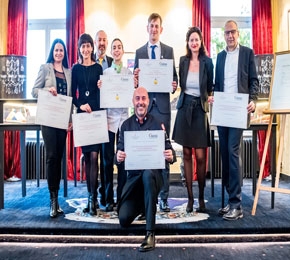- About
- Schools
- Lifelong Education
- News & Events
- Community
Mastering time management: a path to student well-being
#Student Life
Mastering time management: a path to student well-being
Tips and tricks, including the Eisenhower Matrix and the TIC-TOC Method, to master time management for improved well-being.
In the fast-paced world of academia, effective time management is essential for students to achieve their academic goals while maintaining their overall well-being. However, many students struggle with perfectionism, which can hinder their ability to cope with stress and negatively impact their emotional, physical, and relational health. This article will delve into the key strategies of giving up perfectionism, utilizing the Eisenhower Matrix, implementing the TIC-TOC Method, and practical tips to work more efficiently. By adopting these techniques, students can strike a balance between productivity and well-being, leading to a fulfilling academic journey.
How to Give Up Perfectionism
Perfectionism, while often seen as a positive trait, can be a significant barrier to managing time efficiently. Research conducted by Canadian scholars Gordon L Flett and Paul L. Hewitt reveals that perfectionists are under constant stress, leading to emotional exhaustion and unrealistic standards. This constant drive for perfection can act like a brake, preventing students from making progress and leading to a state of "overcontrol" where they push themselves to the point of exhaustion.
To overcome perfectionism, it is crucial to establish realistic objectives and learn to be less stringent with ourselves. Setting high standards is essential, but it's equally important to recognize that perfection is not always attainable. By quieting the inner voice that demands perfection, students can reduce the tendency to overanalyze and self-criticize, allowing for a healthier approach to time management.
The Eisenhower Matrix
The Eisenhower Matrix is a powerful tool for prioritizing tasks and managing time efficiently. Named after former U.S. President Dwight D. Eisenhower, who famously said, "What is important is seldom urgent, and what is urgent is seldom important," this matrix involves dividing tasks into four quadrants based on their urgency and importance.
- Do First: This quadrant includes tasks that are both urgent and important. Students should focus on completing these tasks promptly to prevent last-minute stress and potential setbacks.
- Schedule: Tasks that are important but not urgent fall into this quadrant. By scheduling these tasks for a later time, students can allocate proper planning and preparation, ensuring a more organized workflow.
- Delegate: In this quadrant, students find tasks that are urgent but less important. It is essential to consider delegating these tasks to others, thereby easing the workload and creating space for handling more critical responsibilities.
- Don't Do: Tasks that are neither urgent nor important should be discarded. Engaging in such activities wastes valuable time that could be better spent on more meaningful tasks.
By employing the Eisenhower Matrix, students can streamline their tasks, make informed decisions about how to allocate their time most effectively, and ultimately enhance their overall productivity.
The TIC-TOC Method
Procrastination is a common challenge for students, often leading to increased stress and decreased productivity. The TIC-TOC Method, developed by David Burs, offers a structured approach to overcoming procrastination and enhancing efficiency.
- Identify: The first step is to recognize the important task that you have been putting off. Understand the reasons behind the delay and address any underlying anxieties or fears.
- Remove Distractions: Creating a focused environment is essential for overcoming procrastination. By eliminating sources of distraction, such as turning off social media notifications or finding a quiet study space, students can improve concentration and productivity.
- Improve Perception: The TIC-TOC Method involves rethinking your perspective on the task at hand. Break the task into smaller, manageable steps, set realistic objectives, and visualize successful completion. This approach will make the task seem less overwhelming and more achievable.
- Take Action: Initiate work on the task and maintain momentum by staying committed to the process. Often, taking that initial step can lead to a surge of motivation to continue and complete the task.
- Reward Yourself: Celebrate your accomplishments and progress, no matter how small. Rewarding yourself for completing tasks reinforces positive behavior and can help maintain motivation throughout your academic journey.
By applying the TIC-TOC Method, students can tackle tasks more efficiently, reduce their fear of failure, and experience greater satisfaction in their work.
The TIC-TOC Method and the Eisenhower Matrix are two great techniques to improve time management.
Five Time Management Tips
In addition to the Eisenhower Matrix and the TIC-TOC Method, here are five practical time management tips for students:
- To-Do List: Maintaining a concise to-do list with no more than eight tasks per quadrant of the Eisenhower Matrix will prevent overwhelm and help prioritize essential tasks. Regularly review and update your list to stay on track.
- Single List: Combine both business and private tasks into one list to ensure a holistic approach to time management. This approach will help maintain balance and prevent important tasks from slipping through the cracks.
- Define Your Priorities: Resist external distractions and set your own priorities. Avoid letting others dictate your schedule, and be assertive in protecting your time for the most critical tasks.
- Avoid Procrastination: Address procrastination head-on by using techniques like the TIC-TOC Method and adhering to realistic objectives. Be mindful of potential procrastination triggers and work on overcoming them.
- Be Mindful of Time: Cultivate an awareness of time passing and set specific time frames for tasks. Use timers or apps to stay accountable and avoid losing track of time while working.
Time management is a vital skill for students seeking to excel academically while maintaining their well-being. By giving up perfectionism, utilizing the Eisenhower Matrix, implementing the TIC-TOC Method, and following essential time management tips, students can enhance productivity, reduce stress, and find a balance between academic responsibilities and personal fulfillment. With these strategies in place, students will be better equipped to navigate the challenges of student life and achieve their academic and personal goals with confidence. Remember, time management is not about squeezing every second of the day; it's about making the most of the time available to create a fulfilling and successful academic journey.
#Student Life



















